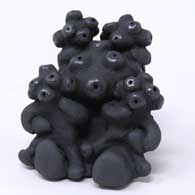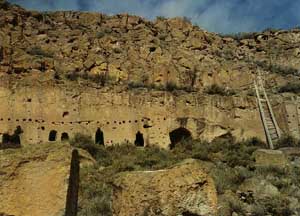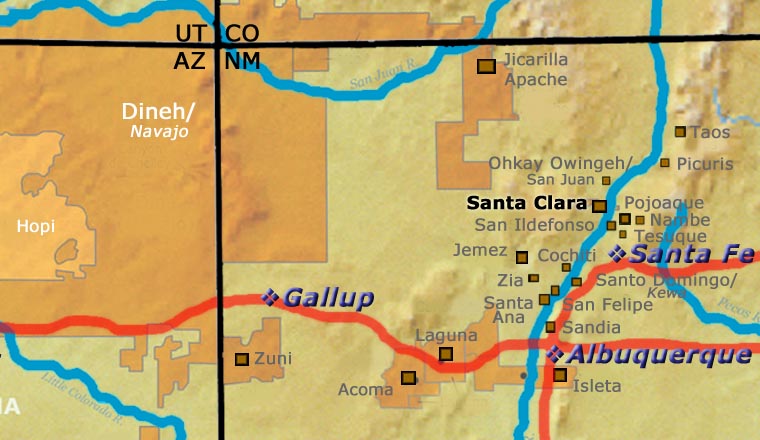
Dorothy and Paul Gutierrez
Santa Clara

Paul White Corn Gutierrez was born to Luther Gutierrez and Lupita Naranjo of Santa Clara Pueblo in 1940. It doesn't appear that Lupita made much pottery as Luther's name is more tied with his sister Margaret's: Luther and Margaret made pottery together in the design tradition of their parents, Lela and Van (Evangelio) Gutierrez.
In 1965 Paul married Dorothy (Corn Maiden), a Dineh woman also born in 1940. Dorothy's mother was a weaver who specialized in belts. Dorothy learned a bit about playing with clay while she was in day school.
Paul started working with clay at home when he was around 12 years old. Working with clay as adults, Dorothy and Paul became known for their mudhead figures. Mudheads (also known as koyemsi) usually have distorted features and are often grouped together like storytellers with their children. They also made Nativities: red or black, matte and polished human and animal figures. Dorothy and Paul also made redware and blackware storytellers, mermaids, angels, ornaments, and buffalo, ram and pig figures.
Working as a husband-and-wife team, Dorothy usually molded the clay and formed the figures while Paul did most of the polishing and finish work. They made everything from miniatures to pieces 6 inches tall, in red and black. Some of their Nativities contained as many as 17 pieces, and as Paul told an interviewer once after ground-firing a set, "They come out different each time, with different faces. It's nice."
Dorothy and Paul were exhibitors at Santa Fe Indian Market from 1981 through 1999. In 1981 they earned First and Second Place ribbons for their figures. There was another First Place ribbon in 1983 for a traditional undecorated piece and a Third Place ribbon in 1984 for a figure. From 1995 to 1999 they were also exhibitors at the Eight Northern Pueblos Arts & Crafts Show at San Juan Pueblo.
Paul passed on in 2017. As of 2022, Dorothy was still alive but no longer making any pottery.
100 West San Francisco Street, Santa Fe, New Mexico 87501
(505) 986-1234 - www.andreafisherpottery.com - All Rights Reserved

Santa Clara Pueblo

Ruins at Puye Cliffs, Santa Clara Pueblo
Santa Clara Pueblo straddles the Rio Grande about 25 miles north of Santa Fe. Of all the pueblos, Santa Clara has the largest number of potters.
The ancestral roots of the Santa Clara people have been traced to ancient pueblos in the Mesa Verde region in southwestern Colorado. When that area began to get dry between about 1100 and 1300 CE, some of the people migrated eastward, then south into the Chama River Valley where they constructed several pueblos over the years. One was Poshuouinge, built about 3 miles south of what is now Abiquiu on the edge of the Jemez foothills above the Chama River. Eventually reaching two and three stories high, and with up to 700 rooms on the ground floor, Poshuouinge was occupied from about 1375 CE to about 1475. Drought then again forced the people to move, some of them going to the area of Puye (on the eastern slopes of the Pajarito Plateau of the Jemez Mountains) and others downstream to Ohkay Owingeh (San Juan Pueblo, along the Rio Grande). Beginning around 1580 CE, drought forced the residents of the Puye area to relocate closer to the Rio Grande and they founded what we now know as Santa Clara Pueblo on the west bank of the river, with San Juan Pueblo to the north and San Ildefonso Pueblo to the south.
In 1598 the seat of Spanish government was established at Yunque, near San Juan Pueblo. The Spanish proceeded to antagonize the Puebloans so badly that that government was moved to Santa Fe in 1610, for their own safety.
Spanish colonists brought the first missionaries to Santa Clara in 1598. Among the many things they forced on the people, those missionaries forced the construction of the first mission church around 1622. However, like the other pueblos, the Santa Clarans chafed under the weight of Spanish rule. As a result, they were in the forefront of the Pueblo Revolt of 1680. One Santa Clara resident, a mixed black and Tewa man named Domingo Naranjo, was one of the rebellion's ringleaders. However, the pueblo unity that allowed them to chase the Spanish out fell apart shortly after their success, especially after Popé died.
When Don Diego de Vargas came back to the area in 1694, he found most of the Santa Clarans on top of nearby Black Mesa (with the people of San Ildefonso). A six-month siege didn't subdue them so finally, the two sides negotiated a treaty and the people returned to their pueblos. However, successive invasions and occupations by northern Europeans took their toll on all the tribes over the next 250 years. Then the swine flu pandemic in 1918 almost wiped them out.
Today, Santa Clara Pueblo is home to as many as 2,600 people and they comprise probably the largest per capita number of artists of any North American tribe (estimates of the number of potters run as high as 1-in-4 residents).
Today's pottery from Santa Clara is typically either black or red. It is usually highly polished and designs might be deeply carved or etched ("sgraffito") into the pot's surface. The water serpent, (avanyu), is a very common traditional design motif on Santa Clara pottery. Another motif comes from the legend that a bear helped the people find water during a drought. The bear paw has appeared on much of their pottery ever since.
Santa Clara has received a lot of distinction because of the evolving artistry the potters have brought to their craft. Not only did this pueblo produce excellent black and redware, several notable innovations helped move pottery from the realm of utilitarian vessels into the domain of art. Different styles of polychrome redware emerged in the 1920s-1930s. In the early 1960s experiments with stone inlay, incising and double firing began. Modern potters have also extended the tradition with unusual shapes, slips and designs, illustrating what one Santa Clara potter said: "At Santa Clara, being non-traditional is the tradition." (This refers strictly to artistic expression; the method of creating pottery remains traditional).
Santa Clara Pueblo is home to a number of famous pottery families: Tafoya, Baca, Gutierrez, Naranjo, Suazo, Chavarria, Garcia, Vigil, and Tapia - to name a few.
100 West San Francisco Street, Santa Fe, New Mexico 87501
(505) 986-1234 - www.andreafisherpottery.com - All Rights Reserved


